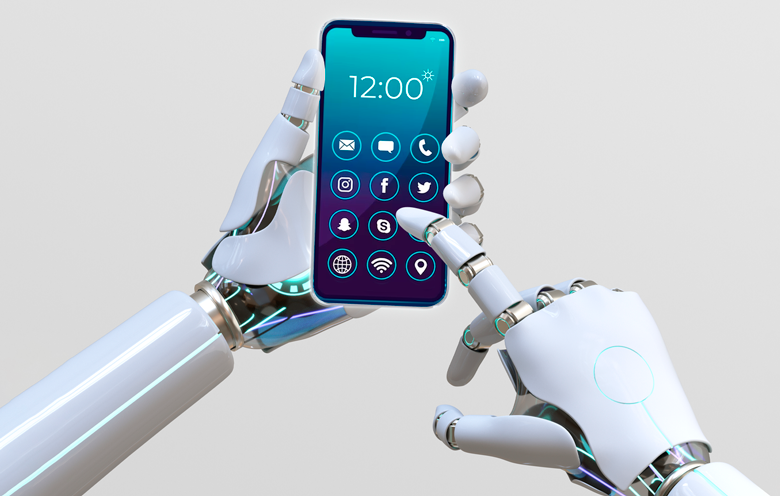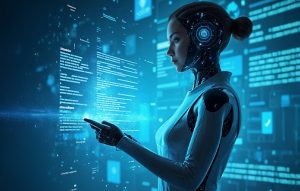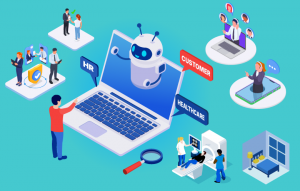AI in mobile app development has grown in popularity in recent years, with every brand developing its own mobile application for users to access their respective products and services. How will you stand out?
Adopt changing trends by incorporating technologies like the Internet of Things (IoT), machine learning (ML), cloud computing, and artificial intelligence (AI) when building mobile apps to gain insights by dynamically utilizing data. AI has gained popularity due to its ability to:
1. Deliver a more personalized experience
2. Reduce manual labor
3. Automate mundane tasks to increase the efficiency of any business
One of its many applications from which businesses benefit is the integration of artificial intelligence in mobile applications. The introduction of artificial intelligence in mobile apps can be game-changing.
Mobile applications powered by AI create a win-win situation for the user as well as for the business by creating value for both.
Enhance user experience with personalized recommendations
The most effective way to use the data collected by intelligent apps is to use it for personalized recommendations to engage your users.
Let’s dive deep into the details of how one can leverage artificial intelligence in ecommerce industry.
How is a personalized recommendation helpful?
1. It improves customer retention by making it easier for them to find products in your store.
2. Providing a personalized shopping experience through product recommendations increases the likelihood of purchasing a product, which increases merchant sales.
3. Once the product recommendation is set up, the machine learns and responds in real time, always leaving room for optimization for a higher ROI and, as a result, increasing the customer lifetime value.
How are e-commerce industries taking advantage of this technology?
Product recommendation algorithms are being used by ecommerce industries to increase customer engagement at various stages of their journey.
- To engage first-time website visitors, sections with the labels “Trending products” or “Best-selling products” are available on the website. If a customer is unsure about what they want to buy, they can use these recommendations to get some ideas.
- You don’t want a visitor’s journey to end as soon as they land on the website’s product page via an ad or search engine result. Merchants can keep visitors engaged on their website longer by displaying related product recommendations based on user behavior.
- Regular website visitors will receive personalized one-to-one recommendations displaying products that the system predicts the user will be interested in viewing next based on data from previous visits.
How does this work?
To begin, you must gather a substantial amount of data about user behavior in your store. This allows you to learn more about the products they view, add to the cart and order.
Our smart mobile app development experts use this data to train the algorithm that will be used regularly to analyze what a user does during a web session. This analysis also tracks product metrics like best-selling products, most popular products, underexposed products and so on.
One of the key benefits of AI in retail is its ability to optimize pricing strategies based on real-time market data and customer demand. This leads to increased revenue and profitability.
Over time, the machine learns about the website’s users’ behavior and combines this information to display real-time product recommendations to users that are optimized to increase the click-through rate. Customize the product recommendations with our experts to influence a buyer’s decision.
Similarly, media and streaming apps use personalized recommendations to keep users engaged with their apps.
For example:
Netflix estimates the likelihood of you watching a particular title in their catalog based on several factors including:
- Your interactions with their services (such as viewing history)
- Other members with similar tastes and preferences
- Based on other information like the titles, such as their genre, categories, actors, release year, etc.
In addition to knowing what you have watched on Netflix, to best personalize the recommendations, they also look at things like:
- The time of day you watch
- The devices you are watching Netflix on
- How long do you spend streaming the app
Fighting financial crime with machine learning
Fraud risks are associated with every financial transaction you make online.
According to LexisNexis’ 2020 report, successful monthly fraud attempts increased by 43% to 48% for mid-to-large retailers and 27% for smaller retailers.
If you are an e-commerce merchant, your top priority will be to protect your app and customers from any cyber fishing activity.
There are typically two methods for preventing fraud.
1. Using rules
It focuses on the long-term processing of obvious fraud scenarios. Usually written in the form of if (so & so) and then (take the defined action) statements. The rules engine takes thousands of such complex rules into account to stop fraudsters.
Limitation: Rules are manually written by analysts. Finding a new signal and creating a rule can take days or weeks. This way, fraudsters will always find a new way to enter the system to commit a new crime.
2. Using machine learning
It focuses on finding hidden correlations in real time. Machine learning knows a clear distinction between normal and fraudulent activity; hence, it finds way more signals than human analysts.
How does it work?
Step1: Training systems from historical data
To minimize false positives, the system understands what normal behavior is. Once it recognizes the normal behavior, it can easily identify what deviates from the normal behavior.
Step 2: Finding anomalies
This is pursued using behavioral analytics, where the system identifies one customer’s behavior and attempts to segment it into a group of other customers with similar interests. After considering all the predictive power of transactional attributes, the machine calculates a fraud score.
If the fraud score is low, the transaction is approved. If it is high, the system flags the transaction for review by the store owner or the customer.
Step 3: Eliminating mistakes
The errors committed by the system could be false positives and false negatives.
False positives occur when the model detects fraud when there is none, which results in transaction failure. False negatives are fraudulent transactions that remain undetected by the system.
To create an almost error-free fraud detection system, a deep neural network (DNN), which is a machine learning mechanism inspired by our brain, is used. It enables finding a non-linear relation between a massive amount of data points without manually selecting transaction attributes.
Computer vision for image and video recognition
There are various ways machine learning uses computer vision for image recognition. Some examples include:
1. Object detection
2. Image classification
3. Facial recognition and emotion recognition
4. Feature matching
5. Video analysis by detecting the presence of specific objects
Google Lens and Pinterest are two popular examples that we use in our daily lives.
Google Lens is an image recognition tool that uses computer vision to identify and understand the contents of an image. Google Lens can be used in real time to scan a QR code, translate text, or receive information about any image.
Similarly, Pinterest is also using computer vision to enhance user experience. Pinterest Lens allows users to search for items on Pinterest using images, instead of keywords. For example, you could just take a photo of a piece of clothing that you like, and Pinterest will show you similar items that you can buy or save.
Explore how computer vision technology can be enhanced with AI to broaden the scope of drone applications in diverse industries.
How does this work?
The image is read by machine learning algorithms in the following ways:
Feature-based image matching: This approach involves extracting features from both images, such as edges, textures and shapes, and then comparing these features to find similarities. The algorithm then scores the match based on how similar the features are.
Deep Learning-based image matching: The neural network is trained on a dataset of images to learn how to extract features that are useful for matching. The features are later compared between the two images to find similarities and score the match based on how similar they are.
Forecasting by artificial intelligence
Artificial intelligence in mobile apps can help with forecasting in a variety of ways for a wide range of industries, including:
Supply chain forecasting:
Smart apps can gather real-time information on inventory levels, shipping times and other logistics details. This data can then be used to make more accurate predictions about future supply chain needs and optimize inventory levels.
Sales forecasting:
A customer’s behavior can be tracked to understand their purchase patterns in real time. This information can be used to make more accurate sales predictions and to identify trends and patterns that can be used to make better business decisions.
Weather forecasting:
Smart apps provide real-time weather data, including temperature, precipitation, wind, and humidity. This information can be used to make more accurate forecasts of future weather patterns and to issue severe weather alerts.
The first step in weather forecasting is to feed large datasets into deep neural networks to learn about the atmosphere. The weather prediction model is learned after all previous weather signals from satellites are fed into a convolutional neural network (CNN). The AI-powered weather signals tool is designed to forecast local weather changes months in advance. The results show that these AI models are computationally cheaper, faster, and more accurate, allowing us to receive weather reports in real time.
Predictive Maintenance:
Smart mobile apps can be used to monitor the condition of equipment and machinery in real time. This data can be used to make precise information about equipment failure and to schedule maintenance more efficiently.
Make your apps smarter!
Artificial intelligence in mobile apps has the potential to greatly enhance the user experience. By utilizing AI techniques, developers can create apps that are more efficient, accurate and personalized for the user.
Our team is constantly looking for ways to ensure that our final solution meets your requirements. Consult our team of mobile app developers today to discuss your requirements. We’d be delighted to work with you!









